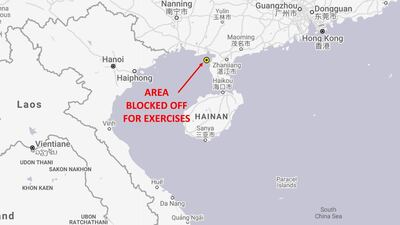China launched a month of military exercises in the South China Sea on Monday and accused foreign countries of heightening tensions by increasing their military presence in those contested waters.
On Friday, China's Maritime Safety Administration announced that an area of roughly 80 square kilometers in Chinese waters to the west of Guangzhou's Leizhou Peninsula and north of Hainan Island would be closed for military exercises between March 1 and March 31.
These exercises come in the wake of numerous foreign military maneuvers in contested areas of the South China Sea, which appear to have drawn Beijing’s ire.
Over the past two months, the U.S. Navy has repeatedly carried out "freedom of navigation operations" (FONOPS) and other such activities in the South China Sea, and French forces have transited the area as well. And other countries, such as the United Kingdom and Germany, are supposedly planning to send naval assets through the region too, RFA has previously reported.
China's Ministry of National Defense said Monday that it "resolutely opposes any country increasing its military presence in the South China Sea under the name of 'freedom of navigation,' creating a tense atmosphere, meddling in regional affairs, and harming the interests of regional countries."

The Maritime Safety Administration announced that the China’s latest military exercises will be occurring within a 5-kilometer radius of a point off the coast of Guangdong in the Gulf of Tonkin. China has not released additional information about these exercises.
The month of exercises launched on Monday is just the latest set of Chinese military activities in the South China Sea, where China, Vietnam, the Philippines, Taiwan, Malaysia, and Brunei are locked in a series of overlapping maritime and territorial disputes.
For instance, Chinese bombers recently carried out maritime assault and maritime strike exercises in the South China Sea region, and People's Liberation Army (PLA) aircraft have repeatedly entered Taiwan's air defense identification zone (ADIZ) between the Pratas Islands and the Taiwanese mainland. States require aircraft to follow certain identification procedures when entering their declared ADIZs.
The PLA Navy also conducted a joint exercise with Singapore's navy last week, state-run Xinhua News reported. According to a report published by the U.S. Naval War College China Maritime Studies Institute in September 2020, the PLA Navy regularly engages in this kind of naval diplomacy in support of various political and strategic objectives.
Oriana Skylar Mastro, an expert at Stanford’s Freeman Spogli Institute for International Studies, told RFA that “Chinese military activities are becoming more and more frequent in the South China Sea.”
“Part of this is natural as the Chinese military becomes more powerful and tries to test and hone its capabilities,” Mastro said.
But these activities are also aimed at communicating Beijing’s resolve and deterring foreign powers, Mastro added.
China’s bid to assert its expansive maritime and territorial claims have driven up tensions in the South China Sea in recent years, drawing in non-claimant states like the U.S., France, and Japan.
Last week, Kyodo News reported that China lodged a protest with Japan in 2018 after two aircraft from the Japanese Self-Defense Force flew near China's artificial island built on Mischief Reef in the Spratly Islands, according to Japanese government sources.
Japan appears to have referenced this incident in a recent diplomatic note to the United Nations, in which it rejected China's baseline claims and denounced China's efforts to limit the freedom of navigation and overflight in the South China Sea. Japan's note was the latest in a series of diplomatic submissions challenging China's claims from the U.K., France, Germany, Malaysia, Australia, the U.S., Indonesia, Vietnam, and the Philippines.
